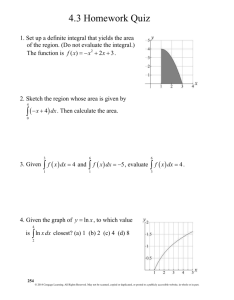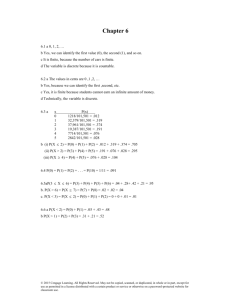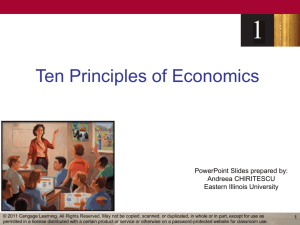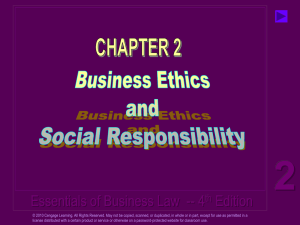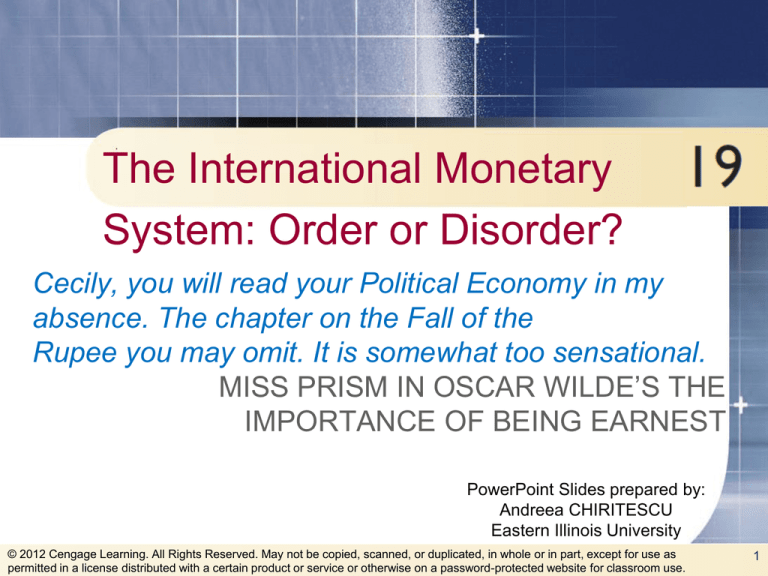
The International Monetary
System: Order or Disorder?
Cecily, you will read your Political Economy in my
absence. The chapter on the Fall of the
Rupee you may omit. It is somewhat too sensational.
MISS PRISM IN OSCAR WILDE’S THE
IMPORTANCE OF BEING EARNEST
PowerPoint Slides prepared by:
Andreea CHIRITESCU
Eastern Illinois University
© 2012 Cengage Learning. All Rights Reserved. May not be copied, scanned, or duplicated, in whole or in part, except for use as
permitted in a license distributed with a certain product or service or otherwise on a password-protected website for classroom use.
1
What Are Exchange Rates?
• Exchange rate
– Price in terms of one currency
– At which another currency can be bought
• Currency in free markets
– Appreciate or Depreciate
• Currency set by government decree
– Devaluate or Revaluate
© 2012 Cengage Learning. All Rights Reserved. May not be copied, scanned, or duplicated, in whole or in part, except for use as
permitted in a license distributed with a certain product or service or otherwise on a password-protected website for classroom use.
2
What Are Exchange Rates?
• A nation’s currency – appreciates
– A unit of its currency buy more units of
foreign currency
• A nation’s currency – depreciates
– A unit of its currency buy fewer units of
foreign currency
• Depreciation to one country
– Appreciation to the other country
© 2012 Cengage Learning. All Rights Reserved. May not be copied, scanned, or duplicated, in whole or in part, except for use as
permitted in a license distributed with a certain product or service or otherwise on a password-protected website for classroom use.
3
What Are Exchange Rates?
• Devaluation
– Reduction in the official value of a
currency
– A unit of a nation’s currency buys fewer
units of foreign currency
• Revaluation
– Increase in the official value of a currency
– A unit of a nation’s currency buys more
units of foreign currency
© 2012 Cengage Learning. All Rights Reserved. May not be copied, scanned, or duplicated, in whole or in part, except for use as
permitted in a license distributed with a certain product or service or otherwise on a password-protected website for classroom use.
4
Table 1
Exchange Rates with the U.S. Dollar
© 2012 Cengage Learning. All Rights Reserved. May not be copied, scanned, or duplicated, in whole or in part, except for use as
permitted in a license distributed with a certain product or service or otherwise on a password-protected website for classroom use.
5
Exchange Rate Determination
• Exchange rate determination in a free
market
• Floating exchange rates
– Rates determined in free markets
– By the law of supply and demand
• Equilibrium exchange rate
– Supply and demand
– No tendency to change
© 2012 Cengage Learning. All Rights Reserved. May not be copied, scanned, or duplicated, in whole or in part, except for use as
permitted in a license distributed with a certain product or service or otherwise on a password-protected website for classroom use.
6
Exchange Rate Determination
• If the exchange rate < equilibrium
– Quantity of currency demanded exceeds
quantity supplied
– Price of currency/exchange rate will
increase
• If the exchange rate > equilibrium
– Quantity of currency supplied exceeds the
quantity demanded
– Price of currency/exchange rate will
decrease
© 2012 Cengage Learning. All Rights Reserved. May not be copied, scanned, or duplicated, in whole or in part, except for use as
permitted in a license distributed with a certain product or service or otherwise on a password-protected website for classroom use.
7
Figure 1
Determination of Exchange Rates in a Free Market
Price of a Euro (in dollars)
D
S
E
$1.50
S
D
Number of Euros
© 2012 Cengage Learning. All Rights Reserved. May not be copied, scanned, or duplicated, in whole or in part, except for use as
permitted in a license distributed with a certain product or service or otherwise on a password-protected website for classroom use.
8
Exchange Rate Determination
• Demand for a country’s currency
– Derived from foreigner’s demand for
• Export goods and services
• Financial assets
• Real assets
• Supply of a country’s currency
– Arises from its imports
– And from foreign investment by its own
citizens
© 2012 Cengage Learning. All Rights Reserved. May not be copied, scanned, or duplicated, in whole or in part, except for use as
permitted in a license distributed with a certain product or service or otherwise on a password-protected website for classroom use.
9
Figure 2
The Effect of Declining Demand for U.S. Assets on the
Exchange Rate
S2
Price of a Euro (in dollars)
D
S1
A
$1.70
$1.50
E
S2
S1
D
Number of Euros
© 2012 Cengage Learning. All Rights Reserved. May not be copied, scanned, or duplicated, in whole or in part, except for use as
permitted in a license distributed with a certain product or service or otherwise on a password-protected website for classroom use.
10
Exchange Rate Determination
• Major determinants of exchange rates, in
the short run
– Interest rates and Financial flows
• Interest rates – increase
– Appreciation of currency
– Higher return to investment - attract more
capital
• Interest rate – drop
– Depreciation of currency
© 2012 Cengage Learning. All Rights Reserved. May not be copied, scanned, or duplicated, in whole or in part, except for use as
permitted in a license distributed with a certain product or service or otherwise on a password-protected website for classroom use.
11
Figure 3
The Effect of a Rise in U.S. Interest Rates
Price of a Pound (in dollars)
D1
S1
D2
S2
E1
$1.75
E2
$1.50
S1
S2
D2
D1
Number of Pounds
© 2012 Cengage Learning. All Rights Reserved. May not be copied, scanned, or duplicated, in whole or in part, except for use as
permitted in a license distributed with a certain product or service or otherwise on a password-protected website for classroom use.
12
Exchange Rate Determination
• Medium run
– A country that grows faster
• Imports – grow faster than exports
• Demand curve for foreign currency shifts
outward more rapidly than the supply curve
• Other things equal: Depreciation
– Stronger economic performance
• Currency appreciation – because it improves
prospects for investing in the country
© 2012 Cengage Learning. All Rights Reserved. May not be copied, scanned, or duplicated, in whole or in part, except for use as
permitted in a license distributed with a certain product or service or otherwise on a password-protected website for classroom use.
13
Figure 4
The Effect of an Economic Boom Abroad on the Exchange
Rate
Price of a Euro (in dollars)
D1
D2
S
A
$1.60
$1.50
E
S
D1
D2
Number of Euros
© 2012 Cengage Learning. All Rights Reserved. May not be copied, scanned, or duplicated, in whole or in part, except for use as
permitted in a license distributed with a certain product or service or otherwise on a password-protected website for classroom use.
14
Exchange Rate Determination
• Purchasing-power parity theory of
exchange rate determination
– The exchange rate between any two
national currencies
– Adjusts to reflect differences in the price
levels in the two countries
© 2012 Cengage Learning. All Rights Reserved. May not be copied, scanned, or duplicated, in whole or in part, except for use as
permitted in a license distributed with a certain product or service or otherwise on a password-protected website for classroom use.
15
Exchange Rate Determination
• Purchasing-power parity theory
– Differences in domestic inflation rates are
a major cause of exchange rate
movements
• If one country has higher inflation than
another, its exchange rate should depreciate
– Worked tolerably well for many years
– Broke down in 1980s and 1990s
© 2012 Cengage Learning. All Rights Reserved. May not be copied, scanned, or duplicated, in whole or in part, except for use as
permitted in a license distributed with a certain product or service or otherwise on a password-protected website for classroom use.
16
Exchange Rate Determination
• Short run
– Other factors are much more important
than relative price levels
• For exchange rate determination
• Long run
– The purchasing-power parity plays an
important role
© 2012 Cengage Learning. All Rights Reserved. May not be copied, scanned, or duplicated, in whole or in part, except for use as
permitted in a license distributed with a certain product or service or otherwise on a password-protected website for classroom use.
17
The Balance of Payments
• When governments fix exchange rates:
the balance of payments
• Fixed exchange rates
– Rates set by government decisions
– And maintained by government actions
• Movements in the supply of and demand
for a currency
– Check the country’s balance of payments
© 2012 Cengage Learning. All Rights Reserved. May not be copied, scanned, or duplicated, in whole or in part, except for use as
permitted in a license distributed with a certain product or service or otherwise on a password-protected website for classroom use.
18
Figure 5
A Balance of Payments Deficit
Price of a Peso (in dollars)
D
1.00
S
Balance of
payments deficit
B
A
E
0.50
S
4
D
8
Billions of Pesos per Year
© 2012 Cengage Learning. All Rights Reserved. May not be copied, scanned, or duplicated, in whole or in part, except for use as
permitted in a license distributed with a certain product or service or otherwise on a password-protected website for classroom use.
19
The Balance of Payments
• Balance of payments deficit
– The amount by which the quantity
supplied of a country’s currency (per year)
• Exceeds the quantity demanded
– Arises whenever the exchange rate is
pegged at an artificially high level
© 2012 Cengage Learning. All Rights Reserved. May not be copied, scanned, or duplicated, in whole or in part, except for use as
permitted in a license distributed with a certain product or service or otherwise on a password-protected website for classroom use.
20
Figure 6
A Balance of Payments Surplus
S
Price of a Yuan (in dollars)
D
E
$0.15
A
0.12
B
Balance of
payments surplus
S
D
600
1,000
Billions of Yuan per Year
© 2012 Cengage Learning. All Rights Reserved. May not be copied, scanned, or duplicated, in whole or in part, except for use as
permitted in a license distributed with a certain product or service or otherwise on a password-protected website for classroom use.
21
The Balance of Payments
• Balance of payments surplus
– The amount by which the quantity
demanded of a country’s currency (per
year)
• Exceeds the quantity supplied
– Arises whenever the exchange rate is
pegged at an artificially low level
© 2012 Cengage Learning. All Rights Reserved. May not be copied, scanned, or duplicated, in whole or in part, except for use as
permitted in a license distributed with a certain product or service or otherwise on a password-protected website for classroom use.
22
The Balance of Payments
• Current account balance
– International purchases and sales of
goods and services
– Cross-border interest and dividend
payments
– Cross-border gifts to and from
• Private individuals
• Governments
– Approximately - net exports
© 2012 Cengage Learning. All Rights Reserved. May not be copied, scanned, or duplicated, in whole or in part, except for use as
permitted in a license distributed with a certain product or service or otherwise on a password-protected website for classroom use.
23
The Balance of Payments
• Capital account balance
– Purchases and sales
• Of financial assets to and from
• Citizens and companies of other countries
• Balance of payments
– Current account
– Capital account
© 2012 Cengage Learning. All Rights Reserved. May not be copied, scanned, or duplicated, in whole or in part, except for use as
permitted in a license distributed with a certain product or service or otherwise on a password-protected website for classroom use.
24
The Balance of Payments
• Does the overall balance of payments
balance?
– If the exchange rate is floating
• All private transactions must add up to zero
– Dollars purchased equals dollars sold
– If the exchange rate is fixed
• Current and capital accounts need not balance
one another
• Surplus or deficit
– Government purchases or sales of foreign
currency
© 2012 Cengage Learning. All Rights Reserved. May not be copied, scanned, or duplicated, in whole or in part, except for use as
permitted in a license distributed with a certain product or service or otherwise on a password-protected website for classroom use.
25
A Bit of History
• A bit of history: the gold standard and the
Bretton Woods system
• Gold standard - Fix exchange rates
– Define each participating currency in
terms of gold
– Allow holders of each participating
currency to convert that currency into gold
• Monetary policy with fixed exchange rates
• Dedicated to pegging exchange rate
• Cannot be used - manage aggregate demand
© 2012 Cengage Learning. All Rights Reserved. May not be copied, scanned, or duplicated, in whole or in part, except for use as
permitted in a license distributed with a certain product or service or otherwise on a password-protected website for classroom use.
26
A Bit of History
• Breton Woods agreement of fixed
exchange rates
– The price of the U.S. dollar was fixed in
terms of gold
– The prices of all other currencies were
fixed in terms of dollars
• Achievements, Breton Woods system
– Re-fix exchange rates
– Restore world trade
© 2012 Cengage Learning. All Rights Reserved. May not be copied, scanned, or duplicated, in whole or in part, except for use as
permitted in a license distributed with a certain product or service or otherwise on a password-protected website for classroom use.
27
A Bit of History
• Flaws, Breton Woods system
– Chronic deficit – balance of payments
– Overvalued dollar
• Bretton Woods system
– Destroyed by the overvalued dollar
– 1971, President Richard Nixon unilaterally
ended the game
• The United States would no longer buy or sell
gold at $35 per ounce
© 2012 Cengage Learning. All Rights Reserved. May not be copied, scanned, or duplicated, in whole or in part, except for use as
permitted in a license distributed with a certain product or service or otherwise on a password-protected website for classroom use.
28
Adjustment Mechanisms
• Fixed exchange rates - Government
– Loses some control over domestic
economy
– Forced to contract economy
• Balance of payments considerations
• When economy needs expansion
– Forced to expand economy
• Balance of payments considerations
• When economy needs to be reined in
© 2012 Cengage Learning. All Rights Reserved. May not be copied, scanned, or duplicated, in whole or in part, except for use as
permitted in a license distributed with a certain product or service or otherwise on a password-protected website for classroom use.
29
Why Try to Fix Exchange Rates?
• International currency speculators
– Buy currency when its value is low
• Help support the currency: push up the
demand curve
– Sell currency when its value is high
• Hold down the price by adding to the supply
curve
– Help limit price fluctuations
– Can destabilize prices only if they are
systematically willing to lose money
© 2012 Cengage Learning. All Rights Reserved. May not be copied, scanned, or duplicated, in whole or in part, except for use as
permitted in a license distributed with a certain product or service or otherwise on a password-protected website for classroom use.
30
The Current “Nonsystem”
• International financial system today
– Blend of fixed and floating exchange rates
– Some currencies - still pegged in the
Bretton Woods manner
– Some countries – adopted the U.S. dollar
– Other countries – tie currencies to a
“basket” of several currencies
– More nations - floating exchange rates
• Some government intervention
© 2012 Cengage Learning. All Rights Reserved. May not be copied, scanned, or duplicated, in whole or in part, except for use as
permitted in a license distributed with a certain product or service or otherwise on a password-protected website for classroom use.
31
The Current “Nonsystem”
• International Monetary Fund (IMF)
– Established at Breton Woods in 1944
– Provides loans – with strings attached
– 1990s, very visible economic crises
• Mexico in 1995
• Southeast Asia in 1997
• Russia in 1998
• Brazil in 1999
– 2001, Turkey and Argentina
© 2012 Cengage Learning. All Rights Reserved. May not be copied, scanned, or duplicated, in whole or in part, except for use as
permitted in a license distributed with a certain product or service or otherwise on a password-protected website for classroom use.
32
The Current “Nonsystem”
• IMF
– Common elements for the crises
• Precipitated by the collapse of a fixed
exchange rate pegged to the U.S. dollar
• The currency plummeted
• IMF - lots of money and lots of advice,
determined to stave off default
• Each country suffered through a severe
recession
© 2012 Cengage Learning. All Rights Reserved. May not be copied, scanned, or duplicated, in whole or in part, except for use as
permitted in a license distributed with a certain product or service or otherwise on a password-protected website for classroom use.
33
The Current “Nonsystem”
• Criticism
– IMF set excessively strict conditions on its
client states
– IMF - serving as a bill collector for banks
and other financial institutions
• From the United States and other rich
countries
© 2012 Cengage Learning. All Rights Reserved. May not be copied, scanned, or duplicated, in whole or in part, except for use as
permitted in a license distributed with a certain product or service or otherwise on a password-protected website for classroom use.
34
The Current “Nonsystem”
• Great Recession, global in late 2008
– A long list of mostly poorer countries
clamored for IMF assistance
– 2010, Greece asked for assistance
• Financing the rescue operation
• Monitoring Greece’s austerity program
© 2012 Cengage Learning. All Rights Reserved. May not be copied, scanned, or duplicated, in whole or in part, except for use as
permitted in a license distributed with a certain product or service or otherwise on a password-protected website for classroom use.
35
The Current “Nonsystem”
• The volatile dollar
– July 1980 a U.S. dollar bought
• Less than 2 German marks
• About 4 French francs
• About 830 Italian lire
– Rising, peaked in February 1985, a U.S.
dollar bought
• More than 3 German marks
• About 10 French francs
• More than 2,000 Italian lire
© 2012 Cengage Learning. All Rights Reserved. May not be copied, scanned, or duplicated, in whole or in part, except for use as
permitted in a license distributed with a certain product or service or otherwise on a password-protected website for classroom use.
36
The Current “Nonsystem”
• The rising dollar
– A blessing to Americans
• Who traveled abroad
• Who bought foreign goods
– Decrease in U.S. exports
• Foreign buyers found everything American
very expensive
– Increase in U.S. imports
– Many U.S. manufacturing industries decimated by foreign competition
© 2012 Cengage Learning. All Rights Reserved. May not be copied, scanned, or duplicated, in whole or in part, except for use as
permitted in a license distributed with a certain product or service or otherwise on a password-protected website for classroom use.
37
The Current “Nonsystem”
• Falling dollar, early 1985 - early 1988
– Decrease U.S. imports
• Rising prices for imported goods and foreign
vacations
– Increase U.S. exports
• Many export industries boomed
• Rising dollar, spring 1995 - early 2002
• 2007–2008, falling dollar
© 2012 Cengage Learning. All Rights Reserved. May not be copied, scanned, or duplicated, in whole or in part, except for use as
permitted in a license distributed with a certain product or service or otherwise on a password-protected website for classroom use.
38
Figure 7
The Ups and Downs of the Dollar
© 2012 Cengage Learning. All Rights Reserved. May not be copied, scanned, or duplicated, in whole or in part, except for use as
permitted in a license distributed with a certain product or service or otherwise on a password-protected website for classroom use.
39
The Current “Nonsystem”
• The birth and adolescence of the Euro
– European Union (EU) goal to create a
unified market with a monetary union
– Treaty of Maastricht (1992)
– 1999, Electronic and checking
transactions in 11 EU nations
– 2002, euro coins and paper money were
introduced
– Number of participating countries: 16
© 2012 Cengage Learning. All Rights Reserved. May not be copied, scanned, or duplicated, in whole or in part, except for use as
permitted in a license distributed with a certain product or service or otherwise on a password-protected website for classroom use.
40
The Current “Nonsystem”
• The Euro
– $1.18 in January 1999
– $0.83 in October 2000
– $1.60 in 2008
– $1.42 today
• Debt crisis of 2010–2011
– Began in Greece
– Spread to Ireland, Portugal, and
elsewhere
© 2012 Cengage Learning. All Rights Reserved. May not be copied, scanned, or duplicated, in whole or in part, except for use as
permitted in a license distributed with a certain product or service or otherwise on a password-protected website for classroom use.
41

